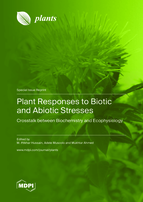Plant Responses to Biotic and Abiotic Stresses: Crosstalk between Biochemistry and Ecophysiology
A special issue of Plants (ISSN 2223-7747). This special issue belongs to the section "Plant Response to Abiotic Stress and Climate Change".
Deadline for manuscript submissions: closed (31 May 2022) | Viewed by 77795
Special Issue Editors
Interests: plant abiotic stress (allelochemicals, salinity, heavy metals) study; plant ecophysiology—photosynthesis (photosystem II photochemistry, stomatal conductance, water use efficiency, carbon isotope discrimination) and leaf water relations; screening, selection, and genotypic evaluation in the plant–soil–environment nexus through agronomic tools and physiological perspective; study of mode of action of plant natural compounds with strong bio-herbicide potential
Special Issues, Collections and Topics in MDPI journals
Interests: salinity, drought, and heat impact on seed germination, seedling growth and metabolism; forest soil management; adaptive response of plants to different environmental constraints; halophytes for the restoration and rehabilitation of salinized or contaminated soils
Special Issues, Collections and Topics in MDPI journals
2. PMAS Arid Agriculture University, Rawalpindi, Punjab , Pakistan
Interests: agronomy; agroecosystems modeling; cropping systems; farm modeling; crop physiology; nutrients cycling; climate change; impact assessments; adaptation and mitigation
Special Issues, Collections and Topics in MDPI journals
Special Issue Information
Dear Colleagues,
Biotic and abiotic stress adversely affect crops’, fruit trees’, legumes’, and halophytes’ growth, development, and productivity. Biotic stress in plants is caused by living organisms that directly deprive their host of its nutrients, leading to reduced plant vigor and in many cases to the death of the host plant. In agriculture, biotic stress is a major cause of pre- and postharvest losses. In contrast, abiotic stress (drought, salinity, cold, heat, and heavy metals) is the principal cause of crop yield loss worldwide, reducing normal yields of the major food, oil-seed, and cash crops by more than 50 percent. In general, biotic and abiotic stresses often cause a series of morphological, physiological, biochemical, and molecular changes that unfavorably affect plant growth and productivity and cause interference in stress tolerance and adaptation. Biotic and abiotic stresses such as drought, salinity, extreme temperatures (cold and heat), and oxidative stress are often interrelated; these conditions, singularly or in combination, induce cellular damage. These stress stimuli are complex in nature and may induce responses that are equally, if not more, complex in nature. For example, severe stresses during critical growth phases may directly result in mechanical damage and changes in the synthesis of macromolecules in cellular settings. In addition, all of these stresses lead to oxidative damage and involve the formation of reactive oxygen species (ROS) in plant cells. Usually, plants have mechanisms to reduce their oxidative damage by the activation of antioxidant enzymes and the accumulation of compatible solutes that effectively scavenge ROS. However, if the production of activated oxygen exceeds the plant’s capacity to detoxify it, deleterious degenerative reactions do occur, typical symptoms being loss of osmotic responsiveness, wilting, and necrosis. Facing stressful conditions, imposed by the changing environmental conditions that affect their growth and development during their whole life cycle, plants have to be able to perceive, process, and translate different stimuli into adaptive responses.
Plant responses to different stresses are highly complex and involve changes at the physiological, biochemical, transcriptome, and cellular levels. Understanding the organism-coordinated responses involves a fine description of the mechanisms occurring at the cellular and molecular level. The current Special Issue of Plants aims to analyze, from a multi-perspective approach (ranging from gas exchange, metabolomics, proteomics, isotopic and genomics, etc.), drivers (e.g., trait selection, phenotypic plasticity) and specific strategies used by the plants at physiological and molecular levels for their better adaptations to stressful growth conditions.
Dr. M. Iftikhar Hussain
Prof. Dr. Adele Muscolo
Dr. Mukhtar Ahmed
Guest Editors
Manuscript Submission Information
Manuscripts should be submitted online at www.mdpi.com by registering and logging in to this website. Once you are registered, click here to go to the submission form. Manuscripts can be submitted until the deadline. All submissions that pass pre-check are peer-reviewed. Accepted papers will be published continuously in the journal (as soon as accepted) and will be listed together on the special issue website. Research articles, review articles as well as short communications are invited. For planned papers, a title and short abstract (about 100 words) can be sent to the Editorial Office for announcement on this website.
Submitted manuscripts should not have been published previously, nor be under consideration for publication elsewhere (except conference proceedings papers). All manuscripts are thoroughly refereed through a single-blind peer-review process. A guide for authors and other relevant information for submission of manuscripts is available on the Instructions for Authors page. Plants is an international peer-reviewed open access semimonthly journal published by MDPI.
Please visit the Instructions for Authors page before submitting a manuscript. The Article Processing Charge (APC) for publication in this open access journal is 2700 CHF (Swiss Francs). Submitted papers should be well formatted and use good English. Authors may use MDPI's English editing service prior to publication or during author revisions.
Keywords
- Abiotic stress
- Photosynthesis
- Plant development
- Plant growth
- Plant metabolism
- Signal transduction
- Stress combinations
- Agricultural sustainable development
- Physiological mechanisms
- Adaptations









